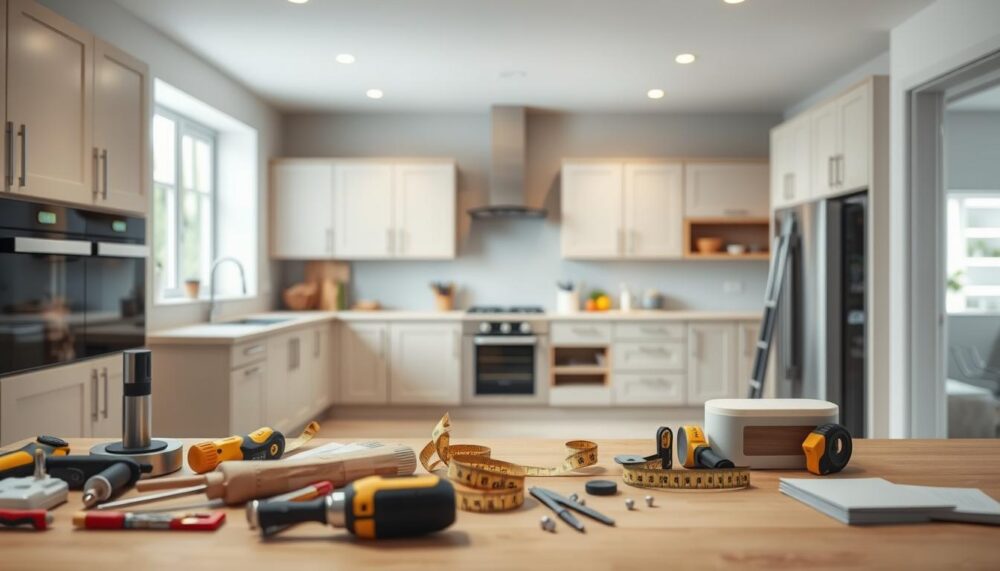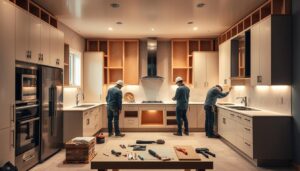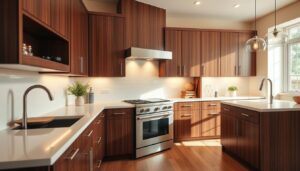Welcome to your friendly guide for creating a stunning new kitchen in your home. This resource breaks down the entire process into manageable stages. Whether you’re an experienced diy enthusiast or just starting, you’ll find clear advice here.
Proper planning and precise measurements form the foundation of any successful project. Getting these elements right from the beginning helps you avoid common mistakes. It also ensures a smooth workflow and saves valuable time later on.
We will cover everything from gathering your tools to making those final tweaks. Following these steps leads to a professional look and a highly functional space. With B&Q’s reliable products, including their impressive 25-year cabinet guarantee, you can proceed with confidence.
This comprehensive manual demonstrates that achieving expert results yourself is entirely possible. Let’s begin this rewarding journey towards your dream cooking area.
Key Takeaways
- Careful planning and accurate measurements are crucial for avoiding errors.
- The entire installation process is broken down into clear, manageable stages.
- Using this guide can help achieve a professional finish and save time.
- B&Q products offer reliability, including a 25-year guarantee on cabinets.
- Even DIY beginners can successfully complete this project with the right guidance.
- Proper preparation ensures a seamless and stress-free fitting experience.
- The end result significantly improves both the functionality and aesthetics of your home.
Gathering Your Tools and Preparing Your Space
Before diving into your project, assembling the right equipment makes all the difference. Proper preparation saves time and prevents frustration later. This step ensures your work proceeds smoothly and safely.
- Spirit level for accurate alignment
- Drill and hammer drill for fixing units
- Clamps to hold cabinets in place
- Cable and pipe detector for safety
- Masking tape, screws, brackets, and wall fixings
- 15mm screws for secure attachments
Measure twice, cut once. This old adage holds true for any successful installation.
Safety comes first. Always disconnect power and water supplies before starting. Remove any old units to create a clear working area. This prevents accidents and gives you a fresh canvas.
Creating a detailed plan on graph paper helps visualise your layout. Mark positions for base and wall units carefully. Double-check all measurements to avoid alignment issues later.
Applying a first coat of paint to walls and ceilings now makes sense. It’s easier than working around new cabinets afterwards. This simple step enhances your finished look.
| Tool Category | Essential Items | Purpose |
|---|---|---|
| Measuring Tools | Spirit level, tape measure | Ensuring precise placement |
| Fastening Equipment | Drill, screws, brackets | Securing units firmly |
| Safety Gear | Cable detector, gloves | Preventing accidents |
| Preparation Materials | Masking tape, graph paper | Planning and protecting surfaces |
B&Q offers convenient Click & Collect services. You can often acquire missing items in little minutes. This service proves invaluable when you discover last-minute needs.
Always read the manufacturer’s instructions thoroughly. Different products may have specific requirements. Understanding these details prevents installation problems.
Organise your materials logically before beginning. Group items by installation stage for efficiency. This approach keeps your workspace tidy and productive.
Common issues arise from poor preparation. Misaligned units or safety hazards often trace back to rushed initial steps. Taking time now prevents headaches later.
Set aside ample time for this preparation phase. Rushing leads to mistakes that cost more time to fix. A methodical approach ensures professional results.
Finally, double-check everything before proceeding. Verify measurements, tool availability, and safety preparations. This attention to detail guarantees a smooth installation process.
How to Fit a B&Q Kitchen: Installing Your Base Units
Now we reach the exciting phase where your kitchen begins taking shape. This stage transforms your careful planning into physical reality. Proper execution here ensures everything fits perfectly.
Foundation work demands precision and patience. Each action builds upon the previous one. Following these steps systematically guarantees professional results.
Establishing a Level Guideline
Begin by creating a perfectly horizontal reference line on your wall. This crucial marker determines your cabinet heights. Use a quality spirit level for absolute accuracy.
Consider appliance heights when setting this line. Your dishwasher and washing machine must align correctly. This foresight prevents awkward gaps later.
Positioning and Levelling the Cabinets
Start with corner units as they anchor your entire layout. Adjust the legs until the cabinet top matches your guideline. Check both front-to-back and side-to-side levelness.
Your spirit level becomes your best friend during this process. Even minor deviations cause significant issues with doors and worktops. Take your time getting this right.
Connecting Adjoining Units
Clamp neighbouring cabinets together once they’re properly positioned. Drill pilot holes using masking tape on your drill bit as a depth guide. This prevents drilling too deep.
Secure units together with appropriate screws. For extra security, consider using connector bolts. These provide additional strength where needed.
“The difference between good and great installation often comes down to millimetre-perfect alignment.”
Fitting Corner Posts for a Seamless Finish
Where cabinets meet at corners, special posts create a clean transition. B&Q offers both fixed and adjustable types to suit different layouts. Choosing the correct corner post depends on your specific measurements.
Fixed posts measure 60x60mm and come as single pieces. Adjustable versions range from 50-2500mm with two components. Both types stabilise units while hiding gaps beautifully.
Follow manufacturer instructions precisely when installing these components. Proper alignment ensures doors operate smoothly and maintains your guarantee.
Securing Units to the Wall
Finally, anchor your cabinets securely to the wall. Use a cable detector before drilling any fixing holes. This prevents damaging pipes or electrical wires.
Angle screws downward slightly for easier access later. Choose wall fixings appropriate for your wall type. Plasterboard requires different fixings than brick walls.
| Common Issue | Prevention Method | Solution if Occurring |
|---|---|---|
| Uneven cabinet tops | Constant spirit level checks | Adjust legs gradually |
| Gaps between units | Proper clamping during joining | Use filler strips |
| Door alignment problems | Perfect levelling during installation | Adjust hinges later |
| Wall fixing failures | Correct fixings for wall type | Reinforce with additional brackets |
Before moving to wall units, double-check every connection. Ensure all cabinets feel solid and secure. This thorough approach prevents future issues.
Remember that proper installation now ensures years of trouble-free use. Your attention to detail creates that professional finish you desire.
Fitting Wall Units and Achieving Perfect Alignment
With your base units securely in place, attention turns to the upper cabinets. This stage brings vertical storage into your layout. Careful execution here ensures a harmonious and functional design.
Wall units demand precision in their placement. Their position affects both aesthetics and practicality. Following a methodical approach guarantees excellent results.
Step 1: Marking Out the Wall Unit Positions
Begin by measuring from your base unit tops. Account for your worktop’s thickness when marking positions. This ensures adequate clearance between surfaces.
Use your spirit level to create both horizontal and vertical guidelines. These marks serve as crucial references throughout your installation. They guarantee your cabinets align perfectly with existing units.
Double-check all measurements before proceeding. Even small errors can cause significant alignment issues later. This careful preparation saves valuable time during fitting.
Step 2: Fixing the Wall Brackets Securely
Follow the manufacturer’s instructions for bracket placement. Typically, you’ll need two brackets per cabinet. Their position must support the unit’s weight effectively.
Choose appropriate wall fixings for your wall type. Different materials require specific screws and anchors. Using incorrect fixings risks instability and safety concerns.
B&Q offers guidance on suitable bracket types for various situations. Their advice proves invaluable for different wall materials. Always prioritise secure attachments.
Step 3: Hanging and Adjusting the Cabinets
Carefully hang each cabinet onto its mounted brackets. Use the adjustment screws to fine-tune their position. Your spirit level remains essential for checking alignment.
Make gradual adjustments until all units sit perfectly level. Ensure they align neatly with neighbouring cabinets. This attention to detail creates a professional finish.
Check that doors will open smoothly without obstruction. Proper alignment at this stage prevents hinge issues later. It also maintains your cabinet guarantee.
“Perfect alignment transforms standard installation into exceptional craftsmanship.”
Common pitfalls include rushing bracket installation or skipping adjustments. These shortcuts often lead to misaligned doors and unstable units. Patience during this process pays dividends.
Take time to verify each cabinet’s position individually. Then check their collective alignment as a group. This thorough approach ensures consistency across your entire installation.
Proper alignment significantly enhances your kitchen’s overall functionality. It also contributes to the visual appeal of your space. These careful adjustments create that expert look you desire.
| Potential Issue | Prevention Method | Solution Strategy |
|---|---|---|
| Uneven cabinet alignment | Frequent spirit level checks | Adjust screws gradually |
| Bracket installation errors | Follow manufacturer instructions | Reinforce with additional fixings |
| Door operation problems | Ensure adequate clearance | Adjust hinges during final fitting |
| Wall fixing instability | Use appropriate fixings | Install supplementary brackets |
Before proceeding to the next stage, confirm all cabinets feel secure. Verify their level positioning from multiple angles. This final check ensures successful completion of this phase.
Remember that quality installation now guarantees years of reliable service. Your meticulous approach creates storage that’s both beautiful and functional.
Adding Drawers, Doors, and Final Adjustments
This exciting stage brings your project to life with functional storage and beautiful surfaces. These finishing touches transform empty cabinets into a complete working space. Attention to detail here creates that professional finish you desire.
Installing Drawer Runners and Assembling Drawers
Begin by fixing drawers runners inside your cabinet frames. Ensure they sit perfectly parallel using your spirit level. This precision guarantees smooth operation later.
Follow the manufacturer’s instructions carefully when assembling drawers. Different designs may require specific assembly techniques. Proper construction prevents future issues.
Slide completed drawers into their runners until they click into place. Check for even gaps around all sides. Minor adjustments now ensure perfect alignment.
Fitting and Aligning Cabinet Doors
Insert hinge mechanisms into the pre-cut holes on your doors. Secure them with the provided screws. Having assistance during this step proves helpful.
Attach mounting plates to your cabinets according to their positioning marks. Connect the doors to these plates carefully. Support the weight during this process.
Check alignment between neighbouring doors and drawers. Even spacing creates a harmonious design. Your spirit level confirms everything sits perfectly.
“The final adjustments separate adequate installation from exceptional craftsmanship.”
Making Precise Hinge Adjustments
Modern hinge systems offer three-way adjustments for perfect alignment. Use a screwdriver for side-to-side, up-down, and in-out modifications. These fine-tuning capabilities solve minor issues.
Test each door after every adjustment. They should close smoothly without catching. Proper alignment maintains your guarantee coverage.
Common pitfalls include using incorrect screw types or rushing this process. Support doors during adjustments to prevent strain on components. Patience delivers superior results.
| Adjustment Type | Purpose | Tool Required |
|---|---|---|
| Side-to-Side | Horizontal alignment | Phillips screwdriver |
| Up-Down | Vertical positioning | Flat-head screwdriver |
| In-Out | Depth calibration | Allen key |
B&Q’s products include comprehensive guidance for this installation phase. Their instructions cover specific requirements for different materials and designs. Following these details prevents functional problems.
Spend adequate time on these final tweaks. Small adjustments dramatically improve overall appearance and functionality. They elevate your project from basic to expert standard.
Test every door and drawer for smooth operation before considering the job complete. This thorough approach ensures years of reliable service from your beautiful new kitchen.
Conclusion: Enjoying Your Professionally Fitted B&Q Kitchen
Your stunning new cooking space now stands complete, a testament to careful planning and skilled work. Following this guide transforms any enthusiast into an accomplished installer.
Your beautiful design combines flawless functionality with impressive visual appeal. Every cabinet and drawer operates smoothly thanks to precise adjustments. This expert finish elevates your entire home.
B&Q supports your achievement with their remarkable 25-year guarantee on units. Should future issues arise, their professional team offers reliable solutions. Share your success using #BandQit to inspire fellow DIYers.
Maintain your magnificent space with regular cleaning and occasional hinge checks. This preserves that pristine look for years ahead. Now relish cooking and entertaining in your exceptional new kitchen.
FAQ
What’s the most important tool for ensuring my cabinets are level?
A spirit level is absolutely essential. You’ll need a good-quality one to establish a level guideline around the room and to check each unit during installation. This prevents wonky cabinets and doors that won’t close properly.
How do I handle awkward corners in my kitchen layout?
B&Q offers corner posts and specific corner units to create a seamless finish. The key is to fit the corner posts securely between your adjoining cabinets, ensuring they are plumb and level for a professional look.
Can I fit the new kitchen units directly over my old tiles?
It’s possible, but not recommended. For the most secure and stable installation, it’s best to remove old tiles or any uneven surfaces. This allows the units to sit flush against the wall, making levelling far simpler.
How long does it typically take to install a B&Q kitchen?
For a confident DIYer, fitting the cabinets can often be completed in a weekend. However, always allow extra time for precise measurements, making adjustments, and dealing with any unexpected issues that might arise.
My walls aren’t perfectly straight. Will this cause problems?
It’s a very common issue! This is where making small adjustments during the installation process is crucial. Use packers behind the units to compensate for any unevenness in the walls before you secure them.
What’s the trick to getting all the cabinet doors aligned perfectly?
Modern hinges are fantastic for this. Once the doors are fitted, you can make micro-adjustments using a screwdriver. Tweaking the screws on the hinge allows you to move the door up, down, in, or out for a flawless finish.






